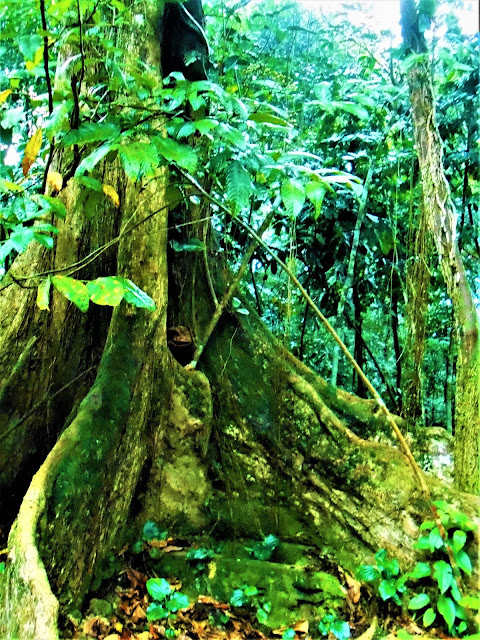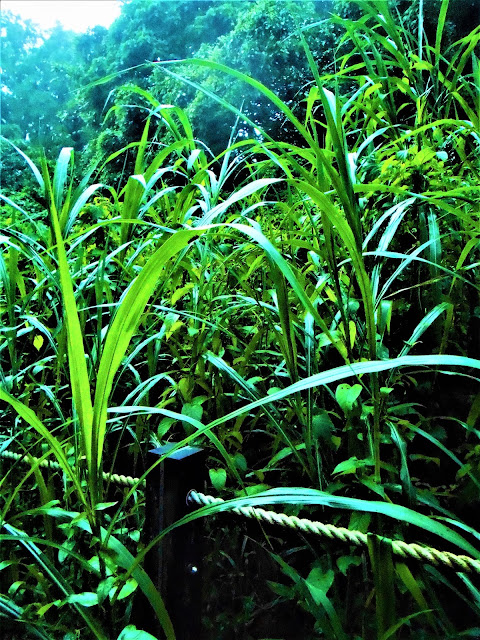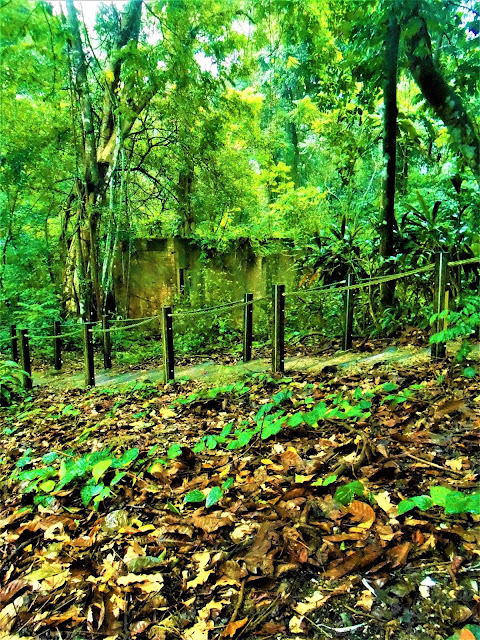An acquaintance told me about the ruins of a Hainan Village "amongst the trees!" that she'd seen whilst forest bathing in Thomson Nature Park.
And because 2021 seems to be the year where I explore the parks of the Central Catchment Area, I went.
One of the best things about going to a new place is when you find yourself discovering more stuff than what you'd originally planned.
I thought the (only) thing I was going to see were the ruins (amongst the trees).
As it turned out, I left the place with a little bit more.
Thomson Nature Park situates itself between the reservoirs of Upper/Lower Peirce, Upper/Lower Seletar, and Windsor Nature Park.
It's a relatively new park (I think), and- based on the solitude the day I was there- doesn't seem as oft visited as, say, the reserves of MacRitchie, Peirce, Henderson Waves or Seletar.
Maybe also because it was so quiet that I was able to properly look at the trees, and one of the first things that struck me was how similar the foliage was to that of the Southern Ridges.
Let me say it first- I'm no plant person- I can't garden, I can't farm, and woe be me if I have to distinguish one tree from the other by only its leaves and bark.
But I can "feel" the difference between one sort of foliage and another, and the trees here reminded me of the forested areas I once saw at Imbiah (Sentosa) and Kent Ridge Park.
It didn't matter which part of the Park I was walking in- whether this intersection or that intersection, whether this road or that road- the foliage all seemed familiar.
And, strangely enough, the feeling became more and more profound the deeper I wandered into the Park.
It might have been the Impressions left behind by the memories.
Or it might have been the warm mist left lingering by the earlier rains.
I cannot emphasize enough how quiet Thomson Nature Park, and I seriously suggest *not* going alone (no matter how much you want to space out and be in touch with Nature).
The whole place is divided into sections, or plots- all of which are presently inaccessible, bordered by rope railings put up by the authorities presumably to keep inexperienced walkers (like me) out.
You're strongly advised to stick to the designated walking paths that at one time would have been 'kampong' roads leading from the main Upper Thomson Road into the heart of the Village.
These roads- silent and empty as they are- retain their names, and if you were to stop and close your eyes, you'd might still be able to sense the distinctive kampong road vibes.
It's hard to put into words what the atmosphere's like- but it immerses you right from the start just as you enter the Park- and doesn't leave you until you step back out onto the main road.
It's like... have you ever been to a place so enclosed that- were it not for your mobile phone- you might have forgotten that you were in present-day Singapore with her concrete housing board flats, her glass skyscrapers, and her system of MRT lines?
That's how the whole place made me feel.
For the entire hour (or so) that I was there, I completely forgot that further up the road northwards were the estates of Yishun and Sembawang, and that coming up from the South I'd passed by Velocity and Courtyard by Marriott right near Novena.
Thomson Nature Park was like a world cocooned within a larger world within an Earth within a Universe.
Made me wonder how life was like for those who once lived there.
The village wasn't isolated- that's for sure.
Neither was the place without life.
They might have been a little far from the shop house structures of our present-day enclaves or even the grandiose architectures by the Padang- but they moved in a circle of their own- a circle familiar to them- a circle from sunrise to sunset day on day, year on year.
I wonder where some of the dwellers are now.
According to the heritage board along one of the roads, the last Villagers left sometime in the mid-80s.
That's.. not very long ago.
It would be lovely to hear some of their stories.
I'd like to know if they lived in zinc roofed houses or attap roofed ones.
I'd also like to know how it was like living amongst the solid-looking structures whose moss-covered ruins I saw amidst the trees.
What were some of these structures used for?
Why did some of them look like they were half buried in the ground?
Were they meant to be that way?
Ohhh, there're so many questions I'd love to ask.
How was it like when it rained? Did the mist drive away the humidity the same way it did when I was there?
Was the rambutan plantation as large as it had always been when it was first established? Where did they sell the rambutans to? Did they make rambutan desserts from the fruit or did they make some sort of jam?
Was it a very lively Village? Did they have a lot of visitors on a regular basis?
Did they have a school- a primary one at least?
Did the mobile cinema come to the Village? Where in the area did they set the screen up? Did the drinks and snacks peddlers come?
I doubt very much I'll get any answers.
Especially since it can be accepted that- after having had to say goodbye to their dwellings of over 90 years- they might want to cherish their memories within the time of their existence- and leave them there.
They might not want to remember.
They might not need to remember.
In a way, that's a good thing too.
After all, the freedom's theirs.
In this world there are some places best left as they are.
It is not necessary for us to have all the answers.
Neither is it necessary for us to probe into years that have been lived and which today dwell in Silence.
We just need to see them as they are.
In the distance, in the Moment of Existence.
And in the space of Time to which they belong.


















